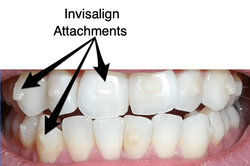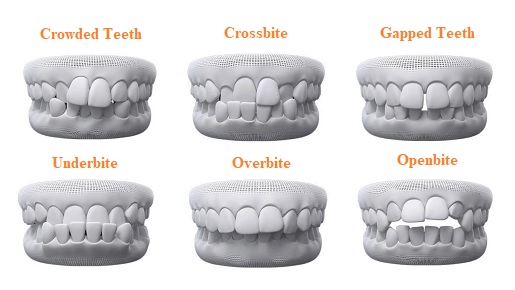Invisalign vs. Conventional Braces: Which Option Is Right for You?
When taking into consideration orthodontic therapy, the option between Invisalign and standard braces provides a number of important factors that merit careful analysis. Invisalign supplies a discreet alternative with detachable aligners, while conventional dental braces supply an extra noticeable yet effective option for serious imbalance. Each option incorporates unique advantages and downsides associated with looks, convenience, therapy period, and cost. Comprehending these subtleties is vital for making an informed choice that straightens with your personal preferences and way of living. The concern stays: which option will finest meet your orthodontic demands and assumptions?
Overview of Therapy Options

In comparison, typical dental braces contain steel braces and cables that are bound to the teeth. This approach uses continual stress in time to achieve placement. While effective for complicated orthodontic concerns, typical dental braces need routine gos to for adjustments and can posture difficulties in maintaining oral health due to the problem of cleaning up about brackets and cables.
Both choices have their benefits, and the selection often rests on specific dental conditions, way of living preferences, and person conformity. Inevitably, speaking with an orthodontic professional is important for establishing the most appropriate therapy plan tailored to specific needs. Comprehending the subtleties of each choice can substantially affect the general success of orthodontic therapy.
Visual Considerations
A significant element influencing the choice in between Invisalign and traditional braces is the aesthetic allure each therapy uses. Invisalign aligners are crafted from clear plastic, making them essentially undetectable when put on.
On the other hand, traditional braces include metal brackets and cords, which can be extra recognizable. While innovations in orthodontic modern technology have actually brought about the advancement of smaller sized brackets and tinted elastics, standard braces still preserve an even more obvious profile. For some individuals, the visibility of dental braces might prevent them from looking for necessary treatment.
Eventually, the choice between Invisalign and typical braces may rest on individual preferences pertaining to looks. Individuals who prioritize discernment often favor Invisalign, while those that are much less worried about presence might choose for conventional dental braces. Recognizing the visual implications of each option is vital for making a notified choice that lines up with one's lifestyle and choices.
Comfort and Convenience

In terms of convenience, Invisalign aligners are removable, enabling patients to enjoy their preferred foods without constraint and preserve optimum dental hygiene. Cleaning and flossing are simplified, as the aligners can be taken out throughout these routines, whereas typical braces need careful maneuvering around wires and brackets.
In comparison, conventional dental braces necessitate routine modifications, making them much less practical for those with active schedules. Overall, the convenience and convenience of Invisalign make it an appealing selection for many individuals seeking orthodontic therapy.
Therapy Duration and Performance
While both Invisalign and conventional braces are effective in fixing dental misalignments, the duration of therapy can vary dramatically in between both alternatives. Normally, Invisalign treatment can take anywhere from 12 to 18 months, depending on the complexity of the situation. The clear aligners work by gradually moving teeth right into their preferred positions, and regular follow-ups with an orthodontist assistance make sure development stays on course.
In comparison, traditional braces commonly require a longer commitment, typically ranging from 18 months to three years. This is because of their set nature and the usage of brackets and wires, which can be much more effective for complex situations and serious misalignments (Invisalign). The treatment effectiveness of conventional braces is well-documented, as they permit navigate to these guys for specific modifications and better control over tooth movement
Inevitably, the option in between Invisalign and traditional braces might depend upon both the awaited treatment duration and the specific oral concerns handy. Consulting with an orthodontist is essential, as they can provide tailored referrals based upon specific requirements, making sure the selected technique straightens with preferred durations and results.
Expense Comparison and Insurance Alternatives
Cost plays a considerable duty in the decision-making process for individuals thinking about orthodontic therapy, whether selecting Invisalign or standard dental braces. Typically, the price of Invisalign varieties from $3,000 to $8,000, while standard dental braces generally cost in between $2,000 and $6,000. Elements affecting these prices consist of the complexity of the case, the duration of treatment, and geographical place.
Lots of oral insurance coverage plans provide partial protection for orthodontic therapies, however the specifics can vary commonly. Typically, conventional braces might be more regularly covered by insurance policy strategies compared to Invisalign, which some insurance companies categorize as a cosmetic treatment.
Additionally, numerous orthodontic practices offer versatile layaway plan, making both therapy choices more obtainable. Individuals ought to make inquiries concerning prospective funding alternatives and discounts for ahead of time settlements. Reviewing the complete expense, including insurance coverage benefits and payment plans, is important for making an informed choice that lines up with both visual preferences and spending plan considerations.

Verdict
In recap, the choice between Invisalign and typical braces pivots on multiple elements, consisting of aesthetic preferences, convenience, therapy period, and expense. Invisalign offers a very discreet, removable option that facilitates oral hygiene and dietary adaptability, while typical dental braces might be preferable for complicated oral problems and often come at a lower cost point. Ultimately, assessment with an orthodontist is important to examine specific circumstances and identify the most ideal therapy option click over here now for achieving ideal oral positioning.
When thinking about orthodontic treatment, the choice in between Invisalign and go to this web-site traditional dental braces offers a number of important elements that merit mindful analysis.Comparing Invisalign and standard dental braces exposes unique therapy alternatives for orthodontic adjustment.While both Invisalign and standard braces are effective in fixing oral imbalances, the duration of therapy can differ significantly between the two alternatives.Price plays a considerable function in the decision-making process for people considering orthodontic treatment, whether deciding for Invisalign or standard dental braces.In recap, the option between Invisalign and typical dental braces pivots on numerous variables, consisting of visual choices, comfort, therapy period, and expense.